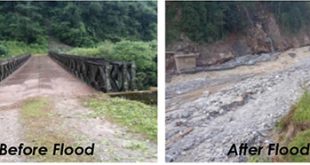
A traditional challenge for Bhutan’s energy sector is that it is hydropower dependent, which means that while it has excess energy in the summer months with overflowing rivers, the reverse is the true in the winter months, with the country even having to import power.
In a bid to overcome this, Bhutan has been looking at a lot of different green options like wind, solar and even hydrogen, but now Bhutan is considering one more energy source for this mix.
Bhutan launched its National Energy Policy 2025 on 30th July 2025 which under the sub-heading ‘Other Energy Initiatives’ says “The Department of Energy shall promote the use of other energy generation sources like Small Modular Reactors (SMR) and other innovative technologies to support long-term energy security.”
Then 14 days later on 13th August 2025 the Druk Holding and Investments (DHI) in its 10x Roadmap for DHI under the ‘Energy Resources’ section, mentions the need for a hybrid energy generation strategy for long term energy security in addition to hydro and solar, and talks about global advances in nuclear power, especially small modular reactors apart from geo thermal, hydrogen, grid scale batteries, etc.
It talks of considering SMRs for baseload generation as the technology matures to diversify power generation, mitigating climate change risks and future-proofing energy security, efficiency and grid security.
The International Atomic Energy Agency (IAEA) says SMRs are advanced nuclear reactors of a smaller size.
SMRs are essentially mini nuclear power plants upto 300 MW which are smaller, safer and portable compared to traditional nuclear power plants.
In SMRs, fissile or fuel like Uranium-235 and Plutonium-239 absorb single neutrons and split to release energy and more neutrons creating more fission. The reactors stabilize this and the resultant heat energy is passed onto a working fluid coolant which in turn drives turbines or electrical generators.
Fuel efficiency is exceptionally high as low enriched Uranium is 120,000 times more energy-dense than coal.
IAEA listing the advantages of SMRs says the benefits of SMRs are inherently linked to the nature of their design, which is small and modular.
Given their smaller footprint, SMRs can be sited on locations not suitable for larger nuclear power plants. Prefabricated units of SMRs can be manufactured and then shipped and installed on site, making them more affordable to build than large power reactors, which are often custom designed for a particular location, sometimes leading to construction delays. SMRs offer savings in cost and construction time, and they can be deployed incrementally to match increasing energy demand.
It says in comparison to existing reactors, proposed SMR designs are generally simpler, and the safety concept for SMRs often relies more on passive systems and inherent safety characteristics of the reactor, such as low power and operating pressure. This means that in such cases, no human intervention or external power or force is required to shut down systems, because passive systems rely on physical phenomena, such as natural circulation, convection, gravity and self-pressurization. These increased safety margins, in some cases, eliminate or significantly lower the potential for unsafe releases of radioactivity to the environment and the public in case of an accident.
SMRs have reduced fuel requirements. Power plants based on SMRs may require less frequent refueling, every 3 to 7 years, in comparison to between 1 and 2 years for conventional plants. Some SMRs are designed to operate for up to 30 years without refueling.
Many countries are in the process of building or designing SMRs, and currently two SMRs that are in operation is the first SMR which is Russia’s Akademik Lomonosov, the world’s first floating nuclear power plant that began commercial operation in May 2020, and is producing energy from two 35 MW SMRs coming to a total of 70 MW.
The second one in operation is in China, which generates 210 MW and consists of 2 reactors called the HTR-PM.
The DHI CEO, Ujjwal Deep Dahal, when asked some questions by the reporter about SMRs was clear that it is not something that Bhutan or DHI is taking up right away, and it will firstly depend on the government policies and technologies, etc.
“I mean, we need to build talent pipeline in these different energy sources. So SMR is one of the areas we are looking at beyond hydro and solar,” said the DHI CEO.
He said while the 10x lists 20 GW out of hydro (15 GW) and Solar (5 GW), the question is how do we diversify beyond that, and here, the others are hydrogen, wind, and SMRs is, again, in the DHI 10X as a placeholder to now start exploring it.
“There would be many policy and regulatory hurdles and constraints that we may need to look at . For one, we don’t have a nuclear energy policy,“ said the DHI CEO.
He said it is DHI’s duty to really bring up what are the potential technologies which may be disrupting the energy landscape in the long run.
“So, if you look at whether it’s SMR or even grid scale batteries, I mean these are important things and the responsibility of DHI as an investment arm is to now bring this technology in the forefront to discuss.”
The DHI CEO again stressed that they are depending on the policies and guidelines of the government which is very important, especially in the SMR story.
“We stand guided by the government in policy regulation. This is beyond the scope of DHI,” said the DHI CEO.
He added, “Of course, what we are saying in the 10x is we need to start talking about this (SMR).”
When asked about the realistic potential of doing it for Bhutan, the DHI CEO said, “To be honest, we are exploring and are setting up meetings with technologists, thought leaders and economists also to see how this comes into the energy mix up of Bhutan. So, I really don’t have a definite answer, but there are SMRs which are done underground these days. It’s a very interesting company and I am trying to reach out to them.”
He explained that this company builds SMRs one kilometer, or about one mile, below the surface, which enhances safety due to the depth. The CEO added that the key question now is whether they are commercially viable, and whether SMRs themselves are commercially viable at this stage.
The DHI CEO further explained that the purpose of including SMRs in the document is to start a national conversation and begin building capacity in this area.
“We need to study that,” CEO Ujjwal Deep Dahal said, and further added, “It is not something that we’re going to invest in next year, of course.”
When asked about the safety and handling aspect of SMRs since these are essentially mini nuclear plants, the DHI CEO said, right now, they don’t, have the capacity and that is why it is just an exploratory move.
“If at all policy allows and regulation allows, then we will be guided by the government. We will have to develop the capacity,” he said.
The DHI CEO said that SMRs is an area that everybody is looking at, and venture capitalists are also looking at. “This is why we are interested to technologically explore it,” the DHI CEO said.
Countries that are building SMRs are Russia, China, USA, Argentina and Canada.
Other countries that have done designs are Japan, South Korea, Denmark, Czezhia, France, South Africa, Sweden, Czech Republic, Indonesia, and there are countries like Singapore looking into its potential.
India’s 2025-26 budget allocates Nu 200 bn to indigenously design and build 5 operational SMRs by 2033.
As of 2025, there were 127 modular reactor designs, with seven designs operating or under construction, 51 in the pre-licensing or licensing process, and 85 designers in discussions with potential site owners. These targets varied outputs and different applications, such as electricity, hybrid energy systems, heating, water desalinization and steam for industrial applications.
Though SMRs have lower upfront capital cost per unit, their economic competitiveness is still to be proven in practice once they are deployed. IAEA says while nuclear reactors provide dispatchable sources of energy, they can adjust output accordingly to electricity demand for some renewables, such as wind and solar, which are variable energy sources that depend on the weather and time of day. SMRs could be paired with and increase the efficiency of renewable sources.
There is a rising global interest from global corporations for SMRs to power data centers.
There are also various options in the SMR technology with options in everything from fueling it to reusing its spent fuel.
 The Bhutanese Leading the way.
The Bhutanese Leading the way.




